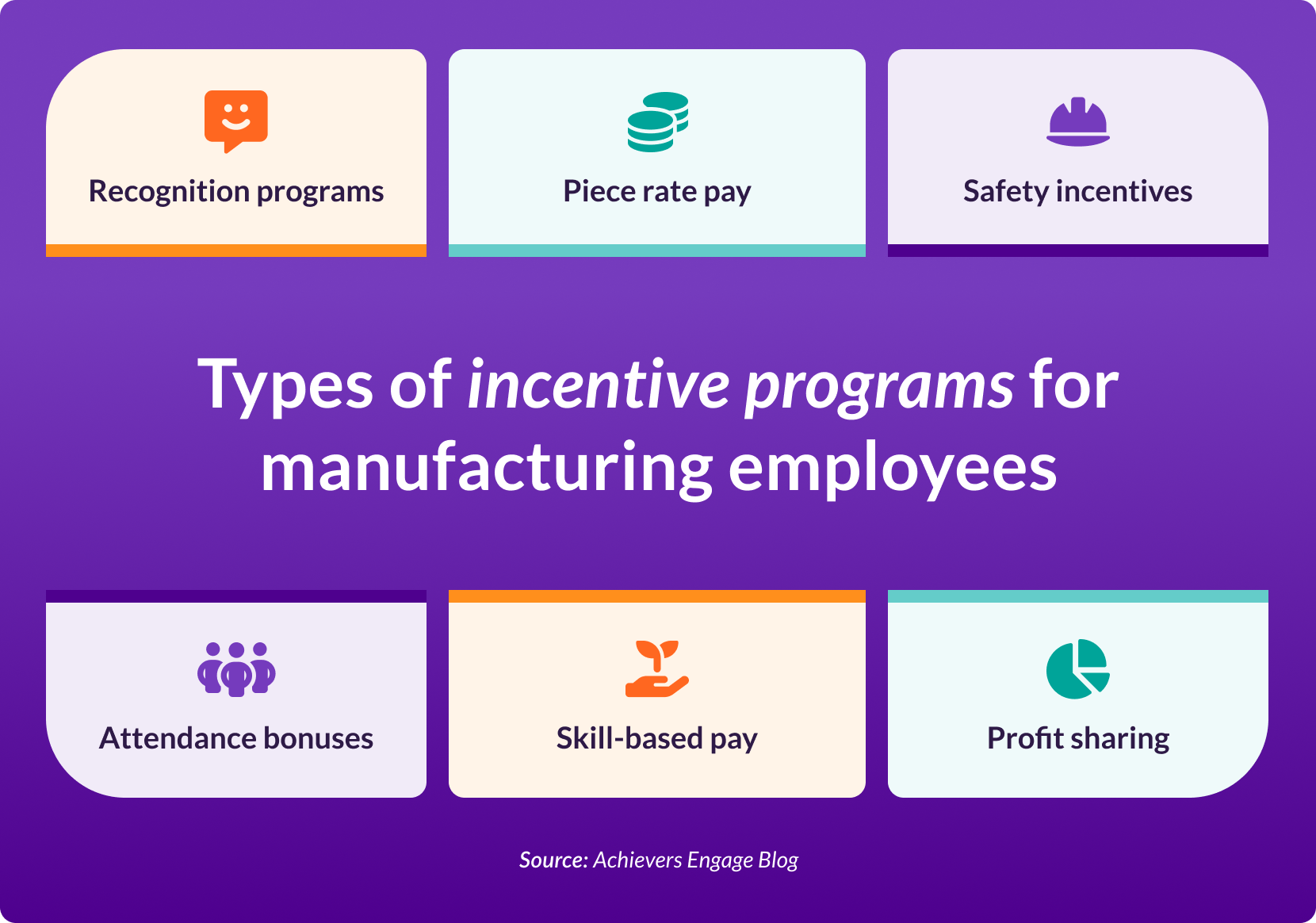Table of contents
When it comes to manufacturing, finding and keeping skilled workers is a bit like striking gold. The challenge isn’t just hiring the right people — it’s holding onto them. High turnover, especially among newer hires, can mean losing employees after you’ve invested in their training.
So, how do you keep them? A strong employee incentive program could be the answer. Start with regular recognition to build a positive culture and encourage safety. By using a customizable rewards platform, you can make it easy for employees to give and receive praise, keeping your team engaged and loyal for the long haul.
In this blog, we’ll explore the best employee incentives for manufacturing, the types of programs that work, and the power of recognition. Plus, we’ll guide you in finding the right tools to implement these strategies. Stay tuned to learn how to keep your workforce motivated and loyal.
What are incentives for manufacturers?
Manufacturers are increasingly recognizing the power of employee incentive programs to drive engagement and productivity. By crafting a mix of financial rewards and non-monetary perks companies can significantly boost morale across their workforce. Recognition plays a key role too, whether through awards or public acknowledgment, reinforcing a culture where employees feel valued and appreciated. This is especially vital in industries where skilled labor is scarce, making retention of top talent a priority. By weaving these incentives into the fabric of the company culture, manufacturers can build a more loyal, committed, and motivated workforce, ultimately driving business success.
How to recognize employees in manufacturing
- Bonuses: Incentives, including bonuses, tied to performance metrics or company profits encourage employees to surpass expectations and drive the company’s success.
- Salary increases: Raises based on merit or scheduled reviews that reward performance and experience, help retain talent, and reflect the value of employees’ contributions.
- Profit-sharing programs: Distributing company profits to employees to align their interests with the company’s financial success and foster a sense of ownership.
- Additional vacation days: Extra paid time off that improves work-life balance, reduces burnout, and enhances job satisfaction.
- Flexible working hours: Flexibility in the workplace means allowing employees to set their own schedules, boosting productivity, job satisfaction, and demonstrating trust.
- Professional development opportunities: Training and growth initiatives that show commitment to employees’ long-term success and provide valuable skills.
- Awards and public acknowledgment: Recognizing achievements through awards to reinforce positive behaviors, boost morale, and increase employee engagement.
How to incentivize factory workers
Keeping factory workers motivated is crucial yet challenging. To truly engage this vital workforce, it’s important to recognize and meet their unique needs. Start with regular, heartfelt recognition for their hard work — this simple act can do wonders for morale and productivity.
Financial incentives, like performance bonuses or profit-sharing, offer concrete rewards that make employees feel invested in the company’s success. But it’s not just about the money; providing opportunities for career growth through training programs or certifications shows workers that they’re valued and have a future within the company.
Don’t overlook the power of flexibility either — adjustable work schedules and additional time off can significantly improve work-life balance and overall job satisfaction. By tapping into these strategies, manufacturers can cultivate a motivated, loyal, and highly productive workforce that drives sustainable growth.

Types of incentive programs for manufacturing employees
Recognition programs
A recognition program is a structured approach to acknowledging and rewarding employees for their achievements, behaviors, and contributions. In manufacturing, such programs boost morale and motivation by celebrating successes and reinforcing desired behaviors. They help improve productivity, reduce turnover, and foster a positive work environment. By recognizing employees’ efforts, manufacturing companies can enhance engagement, encourage continuous improvement, and align individual performance with organizational goals.
Piece rate pay
Piece rate pay compensates employees based on the number of units they produce rather than a fixed hourly wage. In manufacturing, this system can drive productivity and efficiency by linking earnings to output. It motivates workers to work faster and produce more, which can lead to increased production rates and lower labor costs. Additionally, piece rate pay can help align employee incentives with company goals, enhancing overall performance and profitability. However, it’s essential to balance this system with quality controls to ensure high standards are maintained.
Safety incentives
Safety incentives are rewards or recognition given to employees for adhering to safety protocols and contributing to a safe work environment. In manufacturing, these incentives can effectively reduce workplace accidents and injuries by encouraging employees to prioritize safety. By promoting a culture of safety, manufacturers can lower medical costs, minimize downtime, and improve overall productivity. Safety incentives can also boost employee’s psychological safety and overall engagement by demonstrating the company’s commitment to their well-being, leading to a more positive and secure work environment.
Attendance bonuses
Attendance bonuses are rewards given to employees for maintaining a high level of attendance, often over a set period. In manufacturing, these bonuses help ensure a consistent workforce, reducing absenteeism and related disruptions. By incentivizing regular attendance, companies can improve productivity, maintain production schedules, and minimize the costs associated with hiring temporary replacements or dealing with delays. Attendance bonuses also enhance employee morale and commitment, contributing to a more stable and efficient manufacturing operation.
Skill-based pay
Skills-based pay compensates employees based on their proficiency in specific skills or competencies, rather than just their job role or tenure. In manufacturing, this approach rewards employees for acquiring and mastering skills that are valuable to the organization, such as operating complex machinery or adhering to advanced safety procedures. Skills-based pay encourages continuous learning and development, which can enhance productivity and operational efficiency. It also helps attract and retain skilled workers by recognizing and rewarding their specialized expertise, contributing to overall manufacturing excellence.
Profit sharing
Profit sharing is a compensation strategy where employees receive a portion of the company’s profits, often distributed quarterly or annually. In manufacturing, this approach aligns employees’ interests with company performance, motivating them to contribute to profitability through increased productivity and efficiency. Profit sharing fosters a sense of ownership and teamwork, as employees see the direct impact of their efforts on the company’s success. This can lead to improved morale, reduced turnover, and a more engaged workforce, all of which benefit overall manufacturing performance.
Benefits of harnessing the power of recognition
By applying the power of recognition, you can solve a range of manufacturing industry pain points. Utilizing a recognition platform can benefit you in the following ways:
1. Heightened engagement
While the manufacturing industry has recently seen job growth, many new members of the expanding workforce feel disengaged. In a large workforce, it becomes even more challenging to connect with individual employees in a meaningful way. However, the right recognition program can bridge this gap, empowering employees to connect with one another.
Employees who feel valued are more than four times as likely to report high levels of work engagement (59% vs. 13%). Additionally, they are significantly less likely to feel stressed on a typical workday (16% vs. 66%), or to consider leaving the company within the next year (2% vs. 12%). This highlights the critical role recognition plays in not only enhancing engagement but also in fostering a more committed and less stressed workforce.
2. Strengthened retention with Gen Z and millennials
As the manufacturing workforce ages and nears retirement, attracting and retaining fresh talent, particularly among Gen Z and millennials, becomes increasingly vital. A strong culture of recognition not only appeals to younger job candidates but also plays a key role in retaining them.
According to a survey by Resume Builder, the top reason for job hopping is the pursuit of a higher salary (62%), followed by the desire for better working conditions (51%), more growth opportunities (51%), and improved benefits (49%). By addressing these needs through a robust recognition program, the manufacturing industry can build a more engaged and loyal workforce. Strengthening retention among these younger generations ensures a steady pipeline of skilled workers, ultimately benefiting the industry’s long-term growth and stability.
3. An increase in skilled workers
There are various reasons why manufacturing faces a workforce shortage. There aren’t enough STEM program graduates, and the younger generation may perceive the industry as being outdated, unsafe, unclean, or stagnant. Recognizing and appreciating employees regularly for their contributions and growth in skills can make your firm attractive to qualified candidates, even when there are few.
According to Great Place to Work, employees who consistently feel recognized at work are significantly more engaged and motivated compared to those who do not. They are 2.6 times more likely to believe that promotions are fair, 2.2 times more likely to drive innovation and bring new ideas forward, and twice as likely to say that their colleagues are willing to go above and beyond.
4. Established sense of belonging
Recognition is a powerful thing. It’s the human element that’s missing in so many jobs. A lack of recognition makes many good employees quit. The simple act of leaders and peers expressing appreciation for a job well done gives workers a deep feeling of connection and sense of belonging. It lets them know they’re an important part of an effort greater than their individual roles. Employee recognition can vastly improve or get ahead of many challenges, from lowering turnover and improving morale, to driving company culture.
According to Forbes, employees who feel a strong sense of community at work are eight times more likely to experience a sense of belonging. This feeling of belonging drives significant outcomes, including a 43% increase in retention and an 84% boost in estimated tenure or intent to stay.
5. Improved workplace safety
Did you know that 92% of workers agree they are more likely to repeat an action when they’re recognized for it? By recognizing and rewarding employees for displaying behaviors that promote safety — such as following safety protocols, reporting hazards, or supporting their colleagues in maintaining a safe environment — you reinforce these critical actions. Over time, this practice can lead to a more safety-conscious culture where employees are consistently encouraged to prioritize safety in their daily routines.
When employees feel valued for their contributions to a safer workplace, they experience greater job satisfaction and are more engaged in their roles. This heightened engagement not only boosts morale but also reduces the likelihood of accidents and incidents, ultimately contributing to a safer, more productive work environment. The benefits of this approach are clear: a safer workplace leads to happier employees, and happier employees are more likely to stay, perform well, and continue promoting safety long-term.
Find the right tools for employee incentive programs in manufacturing
The right recognition platform can benefit your manufacturing business by enabling:
- Reinforcement of key behaviors
- Recognition that can be given on the go from a mobile device
- A friendly user experience
- A means of tying daily job responsibilities to overarching company values
- Real-time data and analytics
- Greater trust between employees and their management or leadership teams
- Stronger relationships between teams or departments
- Improved employee engagement across your organization
Engage employees with Achievers today
Skilled manufacturing personnel are hard to find, and other firms are competing for top talent. Get ahead of the curve with employee incentive programs for manufacturing. Stand out as a top company to work for using Achievers’ award-winning recognition platform. It can engage your entire workforce and spread appreciation on an everyday basis.
To learn how Achievers can help your manufacturing business build a culture of recognition, request a demo with our retention experts today.



